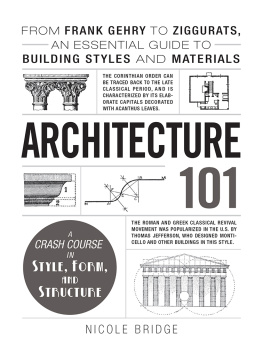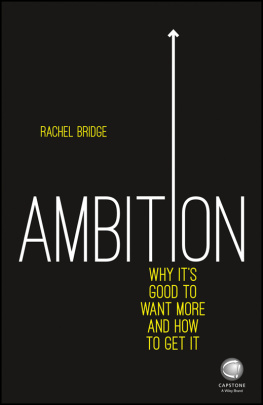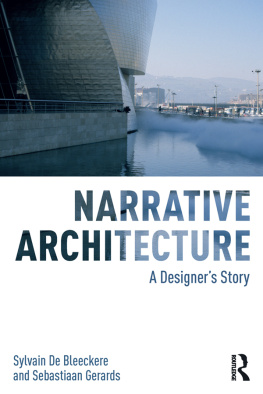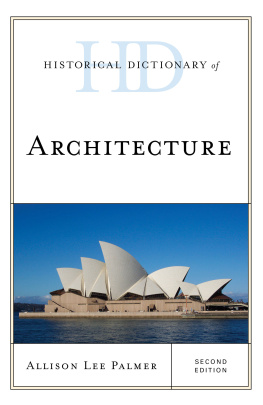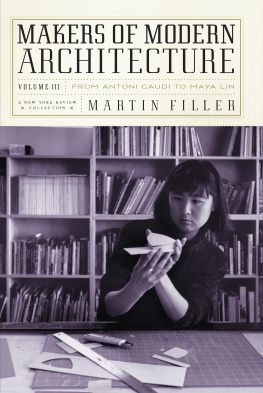Contents
Guide
ARCHITECTURE
FROM FRANK GEHRY TO ZIGGURATS, AN ESSENTIAL GUIDE TO BUILDING STYLES AND MATERIALS
NICOLE BRIDGE

Avon, Massachusetts
To Cliff, M, C, and Jwith love.
CONTENTS
INTRODUCTION
In its most basic definition, architecture is the tangible output of planning, design, engineering, and construction. It is the way we have shaped our environment for thousands of years, the process of building the places in which we live our lives. Architecture emerged as humans transitioned from hunter-gatherers to members of settled civilizations. In early Mesopotamia, residential quarters, courtyards, temples, and administrative buildings formed some of the earliest permanent human spaces. These places made it possible to establish agriculture, religious rituals, a government system, and commerce. They were, in short, the first urban communities.
Today, planning and building is still at the center of our society, but we have also come to appreciate the aesthetics of our constructions. We critique their artistic attributes and admire their innovations as if they were on display in a gallery. In this way, architecture has become a massive public art offering. The tension between the need to build structures that are sturdy and safe and the desire to design something that delights us visually is at the crux of architectures power as an art form. Think of the Empire State Building (1931). The 102 stories on a two-acre plot in the middle of Manhattan constitute an efficient business center, pulsing with more than 150 tenants and seventy-three elevators racing countless employees to their jobs. But when we pass it on the street or see it in the backdrop of a movie or photograph, that limestone and granite faade, the shiny aluminum, the magnificent rows of lights above the observation deck... it becomes something more than its function. It is one of the most iconic pieces of Art Deco, a world-recognized emblem of New York City. It is a testament to the power of architecture.
Even those simple houses back in Mesopotamia were beautifully designed. The Sumerians, their builders, took tremendous care to mold clay with their hands into uniform bricks, patiently dry them in the sun, and place them in elegant stacks. Imagine how mesmerizing those intricate, sand-colored cities must have looked against a clear blue sky 5,000 years ago. In good design, form and function have always lived together.
Todays cities are crammed with layers of different styles and designs. Our structures are a way for us to see who we were and admire who we are becoming. One can marvel over the ornate gothic towers such as Beauvais Cathedral (1225) in France and then turn to the Guggenheim Museum Bilbao (1997) in Spain. A triumph in modern architecture, the intertwined glass, titanium, and limestone museum is unapologetically nestled right into the heart of the old Basque city and has become the most recognized structure on its cherished river view.
As Frank Lloyd Wright said, The mother of art is architecture. Without an architecture of our own we have no soul of our own civilization.
To study architecture is to investigate the heart of our existence. In this space we will examine the great architects, influential styles, and powerful contexts for the most admired and studied structures in the world. Lets take up residence here. Welcome to Architecture 101.
THE STONE AGE
The Earliest Human Settlements
In the beginning, humans were entirely preoccupied with the need to find food. Hunting animals and gathering fruit and grains was their means of survival. Their settlements were semi-permanent homes, functioning almost like a base camp, from which the tribes set forth to hunt and forage. Archaeologists have found evidence of huts built on the Central Russian Plain. These human shelters were organized into settlements, some dating as far back as 14,000 B.C.E . Among the creatures these humans hunted were mammoths, ten-foot-tall hairy elephants. They hunted the mammoths for food, but they also used their carcasses for other things like starting fires, manufacturing tools, and constructing huts. The hunters fashioned the bones into a dome, then filled any gaps between the bones with moss and shrubs before covering the whole structure with turf or a mammoth hide. This enterprise required a tremendous amount of resources; depending on the size of the hut, it could take as many as ninety-five mammoths to build a single structure. In fact, scientists are still not sure if the mammoths became extinct because of climate change or whether overhunting had something to do with it. The largest huts were elaborate enough to include multiple hearths on the inside and openings in the top from which smoke could escape.
Features of the Earliest Huts
- Mammoth bones
- Pine poles
- Animal skin linings
- Central hearth
Jericho
Urban civilizations began appearing much later, around 8000 B.C.E., when crop cultivation had begun to produce enough food that people did not have to move around so much. Now not everyone concerned themselves with food collection and production. People separated into other specialties such as warriors and priests. Humans began settling into permanent spaces and these early farming communities grew into villages often five or ten times bigger than the nomadic hunting settlements before them. Jericho was one of these communities.
Jericho was a fortified settlement positioned on the West Bank. Originally built in 80007000 B.C.E., it was enclosed and protected by a thick stone wall, in places as high as twelve feet, as well as a ditch. A tower about thirty feet rose over the area. The entire city stretched across some ten acres.
The Power of Mud
The earliest dwellings in Jericho, inhabited by hunters and farmers, were mud huts. Mud brick was the preferred building material in this area for thousands of years. It was easy to work with and manufactured from materials that were cheap and widely available. Builders mixed mud and water together with a binder such as reeds or straw and molded them into rectangles. They then set the bricks out in the sun to bake until they were dry. After the bricks were stacked into the desired shape, the walls of the mud brick houses were plastered and painted.
Honoring the Dead
The early civilizations thought constantly about their ancestors. Even the way they built their homes emphasized this part of their culture. They often buried their dead family members beneath the floors of their homes. In the days immediately following the death, they would decorate makeshift shrines to the deceased in their homes with vibrant wall paintings or carvings. The subject of these paintings, like prehistoric cave paintings, was often hunting scenes, wild animal motifs, and cattle. To create these paintings, they would cover the wall with white plaster, almost like a blank canvas. Then they would use pigments bound with fats to make colorful paints. After the grieving period ended, the family would paint over these shrines. In some areas the skeletons of the dead were decorated. Sometimes the bodies were covered with red ocher or the necks and heads were painted with blue and green pigments. They were often buried with jewelry and weapons.

